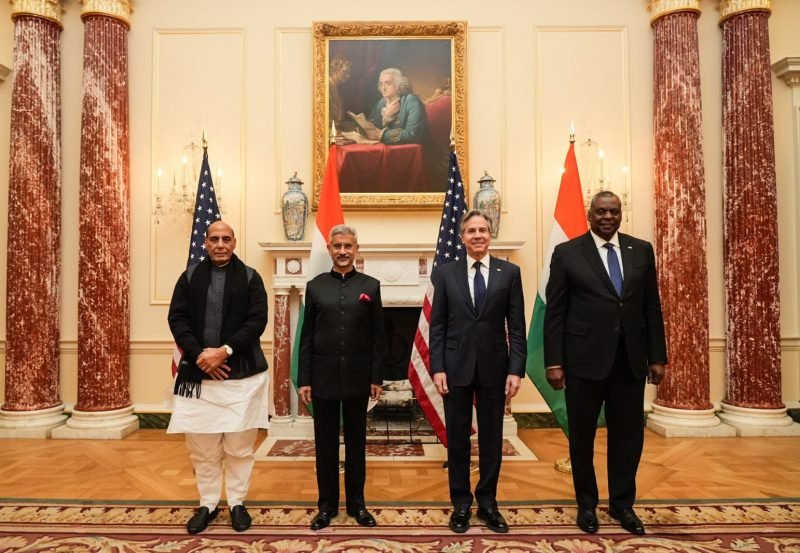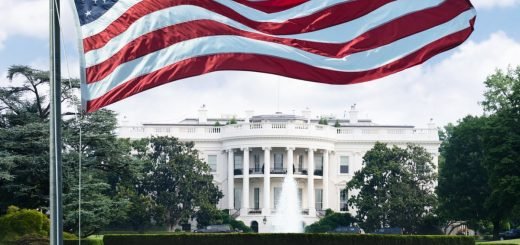Making Sense of the 2+2 Indo-US Dialogue

It is noteworthy that the fourth India-US 2+2 Ministerial Dialogue was very successful and positive with the warmth and understanding Austin and Blinken showed with respect to India’s position on Russia and Ukraine, which was widely witnessed during the joint press meet of the four ministers. If the Russian ‘Special Military Operation’ continues, it may reflect upon the forthcoming Tokyo QUAD Summit in May 2022. Guided by its own national interests, India is not defensive in its position on Ukraine. It came out vividly even in the April 11 virtual meeting wherein the Prime Minister addressing the US President observed that “situation in Ukraine remains very worrisome”.
The External Affairs Minister Jaishankar made cursory reference in opening remarks on April 11 to “contemporary developments, including obviously Ukraine” and the April 11 press statement merely described the “ongoing conflict in Ukraine that has many ramifications”. This 2+2 Ministerial Dialogue was very important at this point in time. India has a regular structured dialogue in this format only with a few countries; as is the case with the USA. As per the tradition, in the 2+2 dialogue, the four ministers jointly call on the Prime Minister of India or the President of the United States depending on where the meeting is being held. It was significant that the virtual summit meeting of April 11 between Biden and Modi also included the respective defence and foreign affairs ministers of both the countries.
The fourth round of Washington DC dialogue sought to provide a deliberate signal by both countries that they did not want the difference over Ukraine issue to come in the way of the broader bilateral relationship. It has been a subtle message to work together where there are convergences. The response of the US Secretary of State during the joint press conference with other ministers to the question about India’s long-standing relationship with Russia was quite revealing. Blinken observed that it is a well-established and long-standing relationship and it developed at a time when the US was not able and willing to be a partner with India. It is both an acknowledgement the past policy flaws as well as realization of the current engagement with India.
Another facet of the US effort is to reassure India about its willingness to be a partner in defense and other matters akin to the strategic role of Russians in the Indian defense calculus. In fact, Defense Secretary Austin spoke about India being a net security provider in the South Asian region. The US interlocutors spoke about working with India for co-development of technology, co-production and jointly doing more not just in terms of military exercises or building the capabilities of the Indian Armed Forces but also in terms of military co-production.
Till now, the US had been looking at Europe and the Indo-Pacific as two distinct theatres. The change came about in 2012-13 during the Obama Administration. Interestingly, to reflect that continuity and change, the current US approach is being spoken about as the Obama-Biden Administration! They had, since the early 2010s, started talking about pivot to Asia or the rebalancing of Asia. As a corollary, the argument has been about stability of the European Security System and tacit acceptance about the main challenge to the USA emanating from China. The said pivot they have been unable to carry out since eruption of the 2014 conflict in Crimea and now the 2022 crisis over Ukraine.
Thus, the US has been disoriented to some extent including in those times when there was continued instability in West Asia. The Trump Administration focused a lot on the Indo-Pacific region. The advent of the emphatic February 24 Russian ‘Special Military Operation’ in Ukraine has dramatically altered security scenario in Europe. NATO has been reduced to be a lame-duck due to the red-lines drawn by Russia that is Russia having the largest number of nuclear weapons in the world (more than 6000). As such the Americans are trying their best to signal that the European, as well as the Indo-Pacific regions, are potential problem areas due to similarities in both the theatres though the dramatis personae are different.

In view of this prevailing situation, the India-US ties in the defense sector appear to be making significant progress as the US seeks to occupy more space amid the gradual tilt seen in New Delhi. The only area where no success has been achieved is in the joint development of defense technology. There is a mechanism known as the defense trade and technology initiative that looks at some projects. It has not yet seen any major breakthroughs. Another area where no success has been achieved is the entry of the US companies for major defense production in India. These are private companies and some of them may be inclined to relocate to India once they get a major defense order. India desires strategic partnership model; wherein the requirement is production in India in partnership with the private sector. Will this policy lead to any substantive results? It remains to be seen. There is a positive indication about future engagement with India and the US signing the Industrial Security Agreement that calls for “collaboration on cutting edge defense technologies between industries”. It shows the nature and intensity of cooperation in the area of defense production and technology between Indian and US companies. It will open the doors for joint Indo-US defense production in India. It portends arrival of state-of-the-art defense technology selectively provided by the US defense manufacturers in their global supply chain. Similarly, the Washington Joint Statement provides a peek into shape of things to come with other areas such as cyber, space and maritime security. We need to keep our fingers crossed as regards the future trajectory of the India-US joint partnership.
India must increase its comprehensive national power by keeping the best possible ties with USA and EU, while managing the threat of China by keeping Russia engaged such that it plays a direct/indirect role in balancing China or in reducing the Chinese belligerence on the Line of Actual Control (LAC). One good example has been the way in which Russia facilitated the peace talks between Jaishankar and Wang Yi on September 10, 2020 when the Ladakh Standoff had the full potential to get converted into an all-out shooting war simply due the Chinese expansionism! It must be appreciated that during the Ladakh Standoff, Russia helped India enhance its deterrence on the LAC with armament supplies as a logical conclusion of the visit by Defence Minister Rajnath Singh to Moscow in June 2020. Also, Russia is critical for Indian interest being observed in Afghanistan and Central Asia.


















